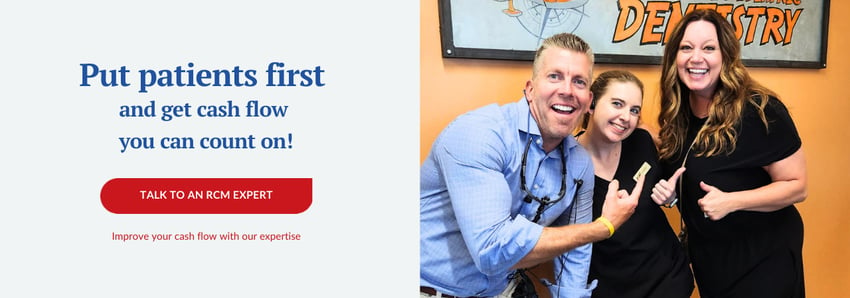Taking different dental insurance types? Avoid 3 billing mistakes


It’s common for dental providers to be credentialed with several different dental insurance plans. From DHMOs, to PPOs, to EPOs, the dentists in a practice may consider a range of plans they could accept in order to expand their patient pool.
The challenge? Getting paid for all those dental claims. When it comes to your dental billing process, you need an efficient way to ensure the different dental insurance plans pay you properly. Each type of dental insurance works differently.
It’s important for dental teams to know how to handle different dental insurance types. Filing more insurance claims that pay out the first time will directly impact the health of your practice.
Dental ClaimSupport has spent the past 10 years helping dental practices that accept all kinds of dental insurance types. Through the years, we’ve seen the common mistakes dental teams make when handling different dental insurance types.
That’s why, in this article, we’ll share 3 mistakes we’ve seen dental teams make when handling different dental plan types. These mistakes are important to avoid, no matter which insurance type you are handling. Once you understand these mistakes, you’ll know how to avoid them.
The fewer mistakes your team makes when handling a variety of insurance types, the faster your claims will be reimbursed, and the healthier your practice will be.
Mistake #1: Not understanding the coverage rules for each different insurance type
It’s hard to bill insurance incorrectly without knowing how the plan works and what fees you can bill.
It’s important to know what fees are covered. For example, a DHMO (Dental Health Maintenance Organization) plan allows the doctor to collect $200 plus the lab fee for a denture. But the office biller did not know they could also collect payment for the lab fee. And, the lab fee is $500.
They claimed only $200 of $700 in benefits they were entitled to collect. The doctor is losing money because he was doing the work, but walking away from most of the money available for reimbursement.
Most DHMO Capitation plans require you to submit an encounter claim form or your standard ADA insurance claim form.
In this case, you submit the services you completed to inform the plan of the services you’ve performed. Some plans may pay an additional amount on certain procedures if negotiated before signing the contract. The encounter form or insurance forms are important to help the practice analyze the plan.
You may receive or request a monthly or quarterly utilization report from the plan. This report assists you with understanding the financial impact of the managed care plan. It will show you your utilization with enrolled patients.
Some practices will use this information to negotiate an increase in the fee schedules or monthly capitation payments. You can then determine if you are being overutilized with capitation patients.
Look at your monthly capitation check and the monthly encounter report on a regular basis. Watch the total dollar amount charged (full practice fee) to patients for that time period. Include patient payments, capitation plan payments (if applicable), and the total write-offs you have applied for that same time period.
This will help you analyze if this managed care plan is a profit or loss. Many practice owners consider the insurance write-offs as marketing dollars because being on the managed care plan helps you gain new patients. It is crucial that the patient pays the proper amount due at the date of service.
Billing a patient on a managed care plan will create more work and increase the overhead thus lowering your profits. When reviewing the contract, make sure that you understand the entire contract including the allowed fee/fee schedule.
Most practices will negotiate the proposed fee before signing the contract. Check your contract to see if the patient has to pay an additional lab fee plus the regular copayment.
PPO (Preferred Provider Organization) and EPO (Executive Provider Organization) plans
When it comes to PPO plans, they are more flexible than other plans because the patient can have coverage with out-of-network providers. PPO plans have an agreed-upon contract with a fee schedule/allowance that may be a bit higher than an EPO plan.
An EPO plan usually has a lower monthly cost to the patient. The patients must go in-network to have coverage on an EPO plan. The EPO provider agrees to a fee schedule that the patient pays, the insurance pays and the practice will write off the difference.
If you don't understand each plan from the start, you're going to have problems collecting on claims. And when you don’t understand the different insurance types - you’re not going to set up the fee schedule/allowance in your practice management software correctly.
Mistake #2: Neglecting to or incorrectly setting up the insurance plan in your practice management software
Setting up that insurance plan is vital.
If the person setting the plan up in your practice management software does not know what they're doing, it can be a disaster. Our billers have seen teams who didn’t have a clear understanding of each plan they were in-network with, and failed to set up the insurance plans in their software correctly.
When this happens, it makes it much harder to post your claim payments and figure out what patients need to pay. If you don't have that plan set up properly, it can also cause your patient to wait longer while you figure out their balance.

Not understanding the plan can also result in collecting the wrong amounts from your patients, especially if you have not updated or asked for an increased new fee schedule from the plan and you forgot to put the new info into the plan.
Office managers or insurance coordinators may be scrambling to figure out the patient payment calculation, having to grab their big binder book that contains the fee schedule. Meanwhile, the patient is waiting for you to let them know what they’re owed. Figuring this all out manually is poor time management!
And as we mentioned above, when the plan is not properly set up in your practice management software - no matter what insurance type is - you will waste your time, decrease your patient collections, increase your practice overhead, receive more insurance claim denials, upset your patients and create possible cash flow problems.
Denials in payments from insurance claims can lead to you never getting what your practice is owed. Don’t let your confusion on different insurance types dictate how much your practice collects! Speaking of confusion, let’s go to the root of the problem in mistake #3.
Mistake #3: Lack of education on billing for different types of insurance plans
Unfortunately, it’s hard to keep all of these different insurance types straight. And insurance companies don’t make it easy to submit claims with guaranteed, quick reimbursement.
But you can’t avoid your responsibility to understand the billing behind different types of insurance plans. Education is powerful, specifically when it comes to insurance billing.
Investing in your dental team’s billing education can lead to a huge return. The more your team understands the rules of protocol for each insurance type, the fewer denials they will face. If you’re wondering where to start on this educational journey, we recommend YouTube videos or enrolling in educational courses such as Dental Claims Academy.
Through courses and community groups, you’ll find that plenty of experts have been where you are and are excited to help you optimize your insurance claims income.
Through insurance billing training, your dental team will feel more empowered and confident to do their job. And your dental practice will also bring in more revenue from the claims process.
Ready to take your dental insurance billing education to the next level to avoid denials?
Understanding different dental insurance types will lead to faster claims income. You’ll spend less time scrambling to calculate patient out-of-pocket costs and you’ll submit more accurate claims. You will be able to understand if these plans are profitable or not with your practice management reports.
By educating your team on the different insurance types, you’ll set up the plans properly in your practice management software and gain more confidence in collecting insurance payments.
To dive further into your dental insurance billing education, sign up for our educational platform, Dental Claims Academy. You’ll gain access to dental billing experts who have years of experience with all insurance types. You’ll be able to attend webinars and have access to community groups as well.
Related Posts
Dental revenue resources from Dental Cashflow Solutions (formerly Dental Claim Support)


